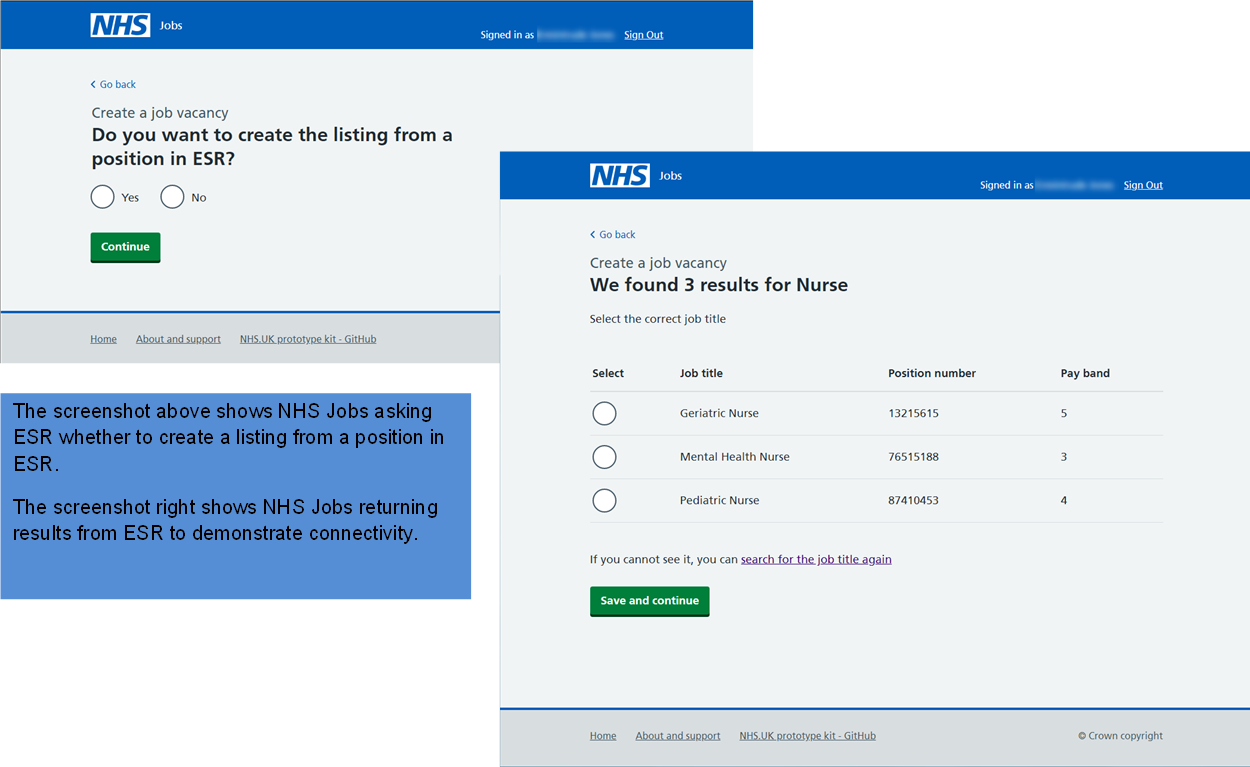ESR supporting the new NHS Jobs service
A number of changes within the ESR solution are being delivered to support the development of the new NHS Jobs service being delivered by NHSBSA, and improve the e-recruitment interface process flows within ESR.
Private Beta has started
Functionality is already being used by NHS Trusts who are testing the new NHS Jobs service in Private Beta – having started in mid-July and is expected to continue throughout the summer.
 Changes for Recruiters
Changes for Recruiters
Recruiters who use the interface between NHS Jobs and ESR will see a number of changes and benefits in the new NHS Jobs service. Feedback from the Private Beta is being sought throughout the period of testing. This work will ensure that the full impact of the changes for users are understood and taken into account. A summary of the flows is set out in the diagram below:
Delivering Benefits to our Users
There are two primary process changes, reflecting work that has been developed in partnership by the NHS Jobs and ESR Teams within NHSBSA Workforce Services. The key changes for recruiters include:
Reduced Manual Input for Position Data
ESR is now able to share position based information from searches made within the new NHS Jobs service, in preparation for creating a vacancy. This means that users can request ESR position data using known attributes, such as organisational cost centre and ESR Position Title. This information will flow into the job advertisement, when it is published, so the user does not have to capture it manually.
The screenshots below are taken from the new NHS Jobs service.

Automatic transfer from NHS Jobs to ESR
 Vacancies are created directly in the e-recruitment service. Users of the new NHS Jobs service can create a vacancy directly within this system, rather than initiating the Requisition and Vacancy Forms and then creating a Recruitment Activity for the Third Party Website within ESR. The vacancy will automatically transfer into ESR, ready for reporting purposes and to support the applicant transfer process later in the recruitment cycle. Vacancies are created directly in the e-recruitment service. Users of the new NHS Jobs service can create a vacancy directly within this system, rather than initiating the Requisition and Vacancy Forms and then creating a Recruitment Activity for the Third Party Website within ESR. The vacancy will automatically transfer into ESR, ready for reporting purposes and to support the applicant transfer process later in the recruitment cycle. |
Additional functionality delivered by the developments include:
- Transfer of the IAT Consent from NHS Jobs to ESR within the Applicant record, supporting the use of the automatically initiated IAT process within ESR. This enables ESR to receive essential information from previous employers, such as mandatory training, at an early stage. This capability will enhance population of the applicant record and support the Enabling Staff Movement objectives, by reducing manual data collection and avoiding the repeat of unnecessary statutory and mandatory training;
- Automated transfer of Projected Hire Date into ESR, once this date is included within the NHS Jobs Service, saving the recruiter time in recording the detail in both systems;
- Once the Professional Registration details for GMC, NMC, HCPC and GDC Applicants are transferred from NHS Jobs, ESR will use its links with these professional bodies to actively monitor the details and report changes back into new NHS Jobs service; and
- The ability to withdraw applicants at the offer stage (Conditional or Unconditional Offer) will allow easier management of vacancies and will result in successful applicants being terminated in ESR.
Future changes
Future developments will ultimately be available to all users of the interface functionality. We already have plans to handle the Termination of Applicants and Termination of Vacancies within the e-recruitment system. Once these changes are developed, this will result in vacancies and applications active within ESR being automatically closed or terminated.
Transition to the new NHS Jobs service
The NHS ESR team is currently working with the NHS Jobs team to plan out the activities to support full rollout of the new service. Further details of the transition process for current NHS Jobs service users will be shared in the coming months. To help recruiters prepare for the transition, our NHS ESR Regional Functional Account Managers will share more detailed information, including any pre-requisites with Trusts in due course.
Plans for the rollout of the new capability for users of other third party recruitment systems will also be agreed and communicated soon.
If you would like to keep up to date with the latest news about the new NHS Jobs service you can subscribe to their magazine. Visit http://nhs_jobs_newsletter and add your details to subscribe.
You can read the NHS Jobs newsletter by visiting https://www.nhsbsa.nhs.uk/nhs-jobs-publications.